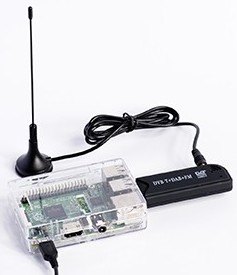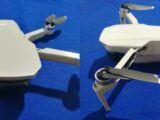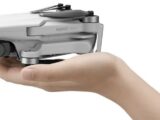
ADS-B For Drones – 1 Safety Feature I’m Looking Forward To
October 23, 2019It’s no secret that drones are making quite an impact as of late. It appears, as they become more prolific, they are getting more coverage and exposure in the news and other outlets.
Sometimes that coverage paints drones in a positive light (think Drone Locates Missing Elderly 88-Year Old Man, or Drones Used to Help Firefighters Track and Put Out the Notre Dame Inferno, etc.) Other times, the coverage shows how people view them as intrusive and used for nefarious reasons (Drone Engaged in Search for Missing Dog Shot Out of the Sky).
Granted, as a relatively new industry, education and legislation are a bit lacking, and the sensationalization of drones in the news doesn’t help either. Still, strides are being made to not only enhance safety but to educate as well. One step in the right direction is ADS-B.
Today’s post will cover ADS-B For Drones including, what it is, why equip drones with it, if it’s required, and how to go about adding ADS-B capability to your drone(s).
Table of Contents
By the time you’re done reading this post, you should have a good overall view of ADS-B in general and how it will enhance awareness and safety for all involved.
Let’s get started…
THIS POST MAY CONTAIN AFFILIATE LINKS. PLEASE SEE MY AFFILIATE DISCLOSURE FOR MORE INFORMATION.
 What Is ADS-B?
What Is ADS-B?
I’m going to start by giving you the boring definition of what the abbreviation stands for. Ready? ADS-B stands for Automatic Dependent Surveillance-Broadcast. Well, doesn’t that explain it all for you? Just in case it doesn’t, let me break it down a bit.
Traditional airspace awareness and control involves Air Traffic Control, radar, and pilots. Each one plays a role in the overall safety of air transportation. Air Traffic Control organizes flights and handles aircraft separation. Radar is the trust-but-verify method commonly used to see where aircraft are in the airspace (as opposed to just taking the pilot’s word for it). The pilot is the one in command and ultimately responsible for the safety of the flight. This is a simplistic view, but you get the idea. Together, they make up a pretty decent overall view of where aircraft are, where they’re going, and which ones might be a hazard to others, etc.
ADS-B is, I don’t want to say replacement so, an enhancement to the situational awareness that radar provides. Radar offers a lot of benefits, but it also has limitations. One major limitation is line of sight. If there’s a mountain or other obstacle between the radar tower and the aircraft, radar won’t see that aircraft. Another is that its information is usually limited to a smattering of screens in a single location. ADS-B introduces GPS into the mix and offers much more detail and data than radar does. On top of that, it allows the sharing of the information gathered to multiple locations and devices.
ADS-B comes in two flavors, in and out. Basically, you can have ADS-B reception capabilities but won’t be able to transmit data if you have ADS-B in only. Guess what ADS-B out does… Yep, it broadcasts that data for other receivers to, well, receive. That’s cool in itself, but what’s cool is ADS-B out can not only broadcast the current aircraft’s position and information, but it can also broadcast the information for any other aircraft that it has.
This mesh network of information reporting dramatically enhances situational awareness and reliability via redundancy. Now you have aircraft reporting their information to other aircraft and towers on the ground who then all repeat that information, passing it down the line (assuming they have ADS-B out), if you will. It basically has built-in fault tolerance. If one aircraft’s or tower’s broadcasting ability fails, the other aircraft and towers continue to pass the data.
With increased accuracy (GPS-based), redundancy, and enhanced data capabilities, who wouldn’t take ADS-B over radar?
 Why Have ADS-B For Drones?
Why Have ADS-B For Drones?
OK, so ADS-B obviously offers benefits to the air traffic control system. Why bring it to drones? To this question, I have three answers (although I’m sure there are more):
Increased Utilization of Drones in Multiple Industries
Let’s face it. Drones are popping up everywhere. With surveys, farming, pipeline or power line inspections, wildlife, and nature uses, just for fun, and more, drones are entering the airspace at record numbers.
This increase in air traffic can become a logistical nightmare for everyone involved. Drone pilots may not know an aircraft, traveling very fast or behind a hill or building, is headed right for their flight area. Air Traffic Control may not be aware of drones in a flight path that they’re handling. Pilots may not be able to see a drone in time to avoid an accident.
There has to be a way to reduce this inherent risk (and there is).
Situational Awareness
Answer this one… Would you prefer to devote 99% of your concentration continuously scanning the sky, looking for any potential hazards and trying to remember which aircraft were going how fast and in what direction, or would you like to be able to see all of that information right on your display screen, with warnings of potential conflicts?
I’m guessing you’d choose the on-screen option. Now, don’t get me wrong, you still need to be scanning the sky, but now you don’t have to do all those calculations and keep track of it all in your head.
Safety
By using a single, primary tool that’s used by the professional air community, safety is greatly enhanced. Everyone’s on the same page and has the same information. Consistency can help alleviate confusion and misunderstanding. It’s just safer overall.
Am I oversimplifying it? I don’t think so. It just makes sense. Besides, many drone pilots fancy themselves as “real” pilots (and some are actual get-in-the-aircraft pilots). Wouldn’t you want to use the same tools the “big boys” do?
 Is ADS-B For Drones Required?
Is ADS-B For Drones Required?
As of the time of this writing, no, but it’s only a matter of time before this, or something very similar to it, is forced upon the droning community.
As it stands now, not every aircraft has to have ADS-B capabilities. In my opinion, they should, but there are circumstances, such as not flying in controlled airspace, that allow aircraft to skip installing/using the solution.
That said, there have been indications that all airspace users will be required to have some sort of remote identification technology in the future. I’d say near-future, but there hasn’t been any indication of and actual timeline, yet. That means drone pilots too (or at least their aircraft).
So, while it may not be a requirement now, just like registering your drone, proper registration mark display requirements, and so on have become law, this will too. It’s just a matter of time.
 How Do I Add ADS-B To My Drone(s)?
How Do I Add ADS-B To My Drone(s)?
That’s an interesting question. I say this for a few reasons:
- I don’t think current drone manufacturers are interested in offering ADS-B solutions for existing aircraft (except maybe their top-of-the-line professional offerings). The way I see it, ADS-B is just another carrot to dangle in front of the drone community as a reason to upgrade to the next iteration.
- There are 3rd-party ADS-B receivers you can install/strap onto your drone that would have their own downlink and receiver. Basically, it’s a secondary system with its own display and base station, so you’d be looking at two separate screens; one for the drone camera view and status and one for the ADS-B information.
- You can set up an ADS-B receiver at your location. You don’t necessarily have to have it on the aircraft itself. Such setups can be bought or even built on the cheap. After all, in the US, your aircraft should be visible to the pilot or designated lookouts at all times. In theory, you should receive the same signals your drone would (within reason).
One interesting tidbit is that DJI has made a sort-of preemptive announcement and has stated that they will be including ADS-B capabilities in all-new drones, released after January 1st, 2020, weighing more than 250 grams. They are calling it AirSense. I view it as a welcome enhancement and believe it will be one of the major selling points of the.
Conclusion
So, now you know about ADS-B, assuming you didn’t know about it already. I’ve covered why use it on drones, talked about the likelihood of it becoming a requirement down the road, options to add ADS-B capabilities now, and even mentioned that DJI plans to equip new models released in 2020 with the technology.
Now I’d like to know your thoughts on all of this. Can you see ADS-B being beneficial? Do you have concerns about it? Do you think it’s just a waste of time and money? Are you a current pilot who’s used the technology and have something to add? Did I get something wrong or miss an important fact? Is there another way to add ADS-B to existing drones? Let me know by commenting below. I’d love to hear what you have to say.
Thank you,
Scott Hinkle
MavicManiacs.com





This I must say is a very useful and informative article.
This is actually the first time I’m learning about what an ABD-B is and why use it for drones, it’s very nice to know that it offers a quite number of things to technology and the most important part of it all, it ensures safety which makes it important.
I actually think using this kind of tech is very resourceful and of immense benefits, I think it should be considered soon.
You’ve got a very interesting topic here, it’s really nice.
Thank you,
ADS-B has been in use for a while now in private and commercial planes/aircraft. I think it’s a great feature for drones as well.
Thanks for taking the time to comment.
Scott
Enhances situational awareness, hitting the nail on its head.
ADS-B sounds like radar on steroids, no?
I like how some folks complain about drones being intrusive. Well, true that, however..
..what happens in next 30 years?
At the moment we have these cute, little toys flying around. What happens & how would we feel if there’s a bulky unmanned aircraft scanning our backyard on daily basis in near future?
Definitely looking forward to that experience as it is going to create some mighty interesting social situations.
Soon, a petty thief can’t even steal candy from local shop without having a drone notice & record it.
On contrary, what happens if criminal enterprises themselves starts to operate these machines on a larger scale?
However, from technical standpoint I believe ADS-B sounds like a big step forward.
It is a fact that airspace is packed tight with planes & maintains an unceasing traffic, collisions included or not.
If I have say in it, I’d rather choose safety first.
Plus ADS-B sounds fancy, that doesn’t hurt.
Hello there,
I see ADS-B as a way to partially verify where drones are and, to some extent, what they[re up to (you can see if a drone is hovering over your property, etc.). You can build an ADS-B receiver really cheap and see air traffic in your area.
I agree, ADS-B is a big step forward.
Thanks for commenting,
Scott
It is my own nature to always lookout for safety measures in every possible way because it actually determines how long our existence counts and lasts.
ADS-B for drones is really a nice idea and I think it should be embraced by everyone in need of that kind of service. Being able to see beyond obstacles compared to radar is very nice as it gives safety, this means that it can monitor the position of the aircraft it’s connected to and also others attached to it.
This is a very valuable information that will be of great help to humans.
Thanks
I’ll admit, sometimes I get excited about something and jump right in, without thinking about safety.
That said, I agree that ADS-B should be embraced by all in the droning community. It will only lead to safer flight operations.
Thank you for taking the time to comment,
Scott
I put (had to) ADS-B on a certified aircraft, cost $6K, added an ADS-B Transceiver to a ultra-lite, $1,200.00. The Raspberry PI with a SDR receives but doesn’t transmit, the transmitting part and the Certified GPS is the cost and what makes ADB-S useful, without the ability to transmit no one would know the drone exist.
Besides, unless the aircraft is landing, aircraft and drones fly in different airspace (altitude wise). While I can trespass higher than the 400 AGL the FAA has set as the dividing line between aircraft and drones I would be breaking the law. When I hear an aircraft I make sure my drone is at less then 50 feet, power pole height, and in the case of crop dusters I land, they are not predictable!
Hopefully the NEW L5 GPS satellite ‘Safety-of-Life’ will lower the cost of the GPS subsystem, with L1+L2+L5 devices there will be mm based systems at 50 updates per second without the need of ground based correction.
Hello,
First off, thanks for taking the time to comment.
I totally get where you’re coming from. I’ve been on and off with my Private Pilot license endeavor for years now. I either have money or time but never both simultaneously. Sadly, I cut just short of my solo last time.
Yes, a transceiver would be ideal but I’d still argue that, at least from the drone pilot’s perspective, seeing other aircraft in the vicinity does add to safety and awareness. Knowing where other aircraft are, and having that information on your controller display alongside your drone just adds that extra layer.
What I’m hoping for, and I don’t have the details, is that DJI’s solution will somehow connect to the ADS-B network (assuming the controller/device has a network connection – cellular or WiFi) and relay the GPS coordinates of the drone allowing others that use the system to see it’s location as well. I know it’s not a true ADSB transceiver solution but it would be another step in the right direction.
My reference to the Raspberry Pi option was just to point out that you can at least see where other ADS-B equipped aircraft are at a low-cost entry point.
I was unaware of the new L5 GPS solution. I look forward to learning more about it.
Thanks again,
Scott
DJI announced plans to allow anyone with a smartphone to track and obtain info about drones nearby: https://www.theverge.com/2019/11/13/20963702/dji-drone-remote-identification-smartphone-app
I must say this is a very useful article. I did learn a lot from the article and comments.
But if I may ask a few questions that I’m still confused about ADS-B application on drones.
1. The biggest problem for ADS-B application on drones seems to be ADS-B transmitters on drones, too expensive for drones. Maybe the ADS-B transmitter cost is OK for big UAVs. But too expensive for drones.
2. If ADS-B transmitters installed on drones, this would mean a lot of ICAO address needed. This should cause a new rule for ICAO address management?
3. Even just for ADS-B receiver installed on drones, still cost not a small money. Cheaper than ADS-B transmitters, but still cost not a small.
I personally very welcome more and more ADS-B applications, because I work on ADS-B. 🙂 But still I got this confusion. Maybe some friends can help explain?
ADS-B is cost prohibitive at this time for recreational drones, and there are concerns that adding so many more aircraft with ADS-B could overwhelm the system. Also, most recreational drones operate in airspace where ADS-B is not required.
Here’s the latest from the FAA website:
https://www.faa.gov/faq/what-ads-b-will-ads-b-be-required-small-uas-or-drones-future